Tunas, alongside mackerels and bonitos, belong to the Scombridae family, and are further classified within the Thunnini tribe, a grouping that encompasses all tuna species, highlighting their shared evolutionary lineage.
There are 15 species of tuna. In the commercial tuna market, there are 7 “main” species and 8 “minor” species. Here we focus on the seven main types of tuna: Skipjack, Albacore, Yellowfin, Bigeye, Atlantic Bluefin, Pacific Bluefin, and Southern Bluefin.
Main Vs Minor Types
The commercial fishing market is broken into the main and minor species of tuna listed below. The eight minor species are still caught commercially and recreationally but not nearly in the volume as the main seven.
| 7 Main Types | 8 Minor Types |
|---|---|
| Skipjack | Black Skipjack |
| Albacore | Blackfin Tuna |
| Yellowfin | Bullet |
| Bigeye | Frigate |
| Atlantic Bluefin | Kawakawa |
| Pacific Bluefin | Longtail or Tongol |
| Southern Bluefin | Little tunny |
| Slender |
Catch Volume By Species
According to the most recent data from ISS Foundation, in 2022, the total catch of main commercial tuna types was 5.2 million tons. You can see below that skipjack and yellowfin account for a whopping 87% of all tuna caught in the world.
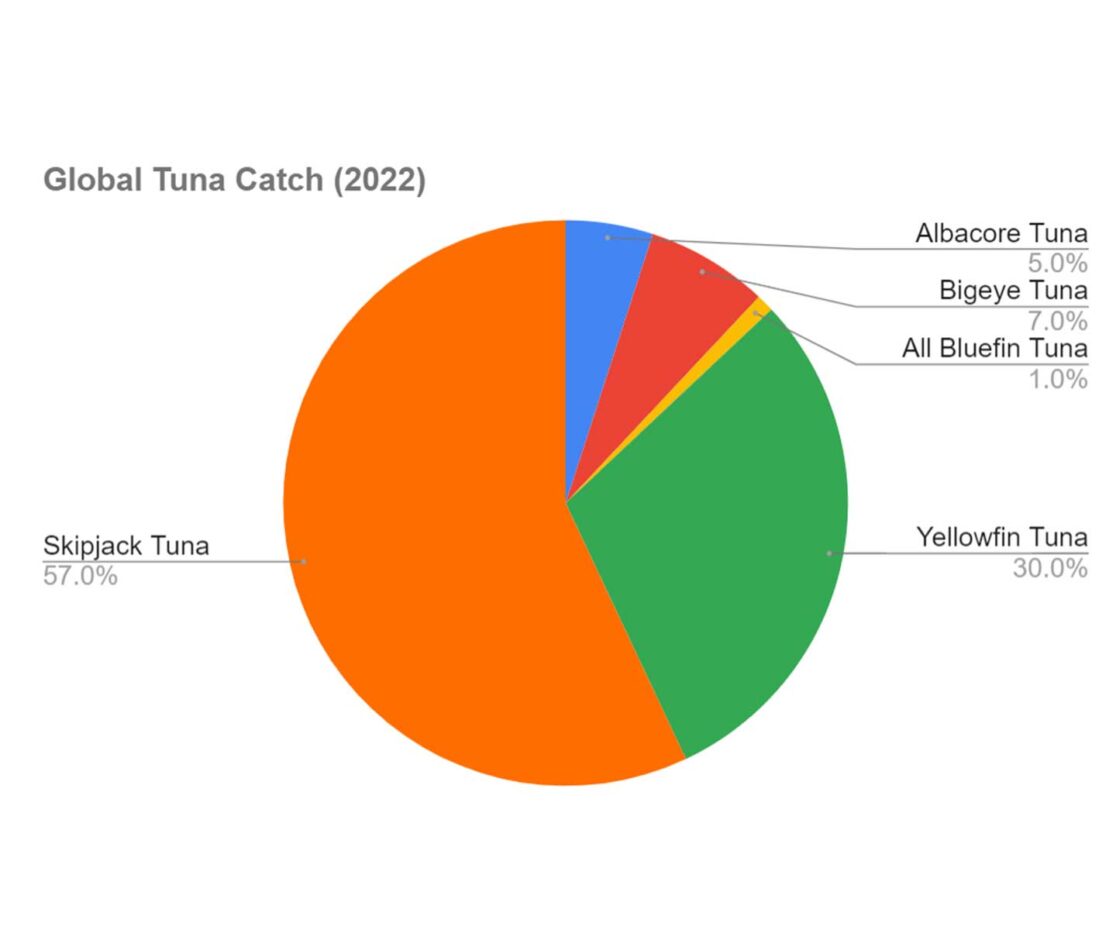
Size By Species
The below figures show the dramatic differences in size between the main tuna types. For example, you’d need to catch 27 Skipjack to equal one Atlantic Bluefin!
| Tuna Species | Maximum Weight | Maximum Length |
|---|---|---|
| Skipjack Tuna | 75 lbs | 3.5 ft |
| Albacore Tuna | 90 lbs | 5 ft |
| Yellowfin Tuna | 400 lbs | 7 ft |
| Bigeye Tuna | 400 lbs | 8 ft |
| Atlantic Bluefin Tuna | 2,000 lbs | 10.5 ft |
| Pacific Bluefin Tuna | 990 lbs | 10 ft |
| Southern Bluefin Tuna | 1,210 lbs | 8 ft |
Note: these figures are estimates and will vary based on age, location, and the individual fish.
Main Types of Tuna
Here we profile each of the seven major tuna species in greater detail.
Skipjack
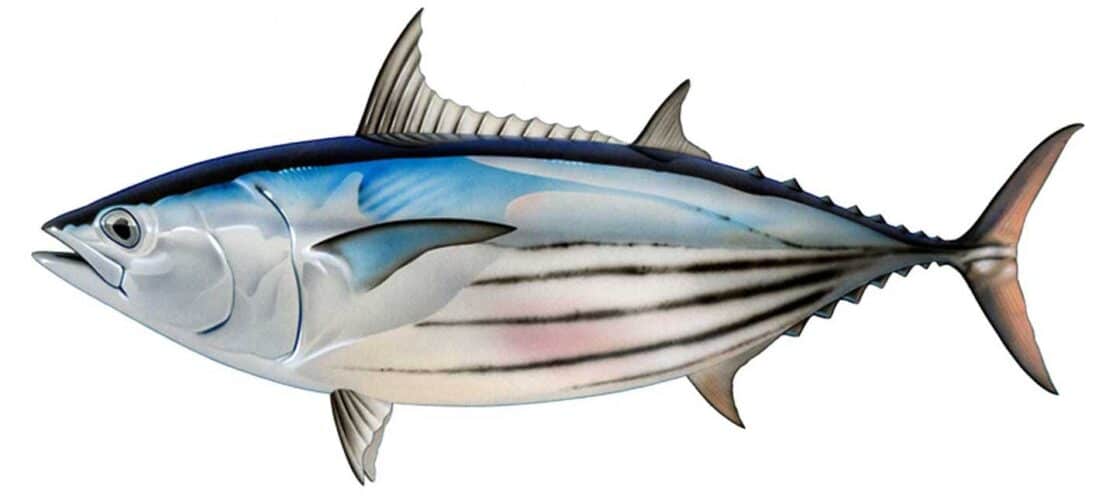
Latin Name: Katsuwonus pelamis
Maximum Weight and Length: 75 lbs, 3.5 ft
Habitat: Tropical and warm temperate waters worldwide, but mainly in the Atlantic Ocean, Indian Ocean, and Pacific Oceans. They’re often found in large schools near the surface.
Distinguishing Features:
- Iridescent blue with black markings on the back
- Bullet-shaped body
- Tender meat, often used for canning
- Smaller size compared to other tuna species
- Learn more about Skipjack
Taste and Texture: Skipjack has a stronger, fishier flavor and a softer texture than most other species.
Yellowfin
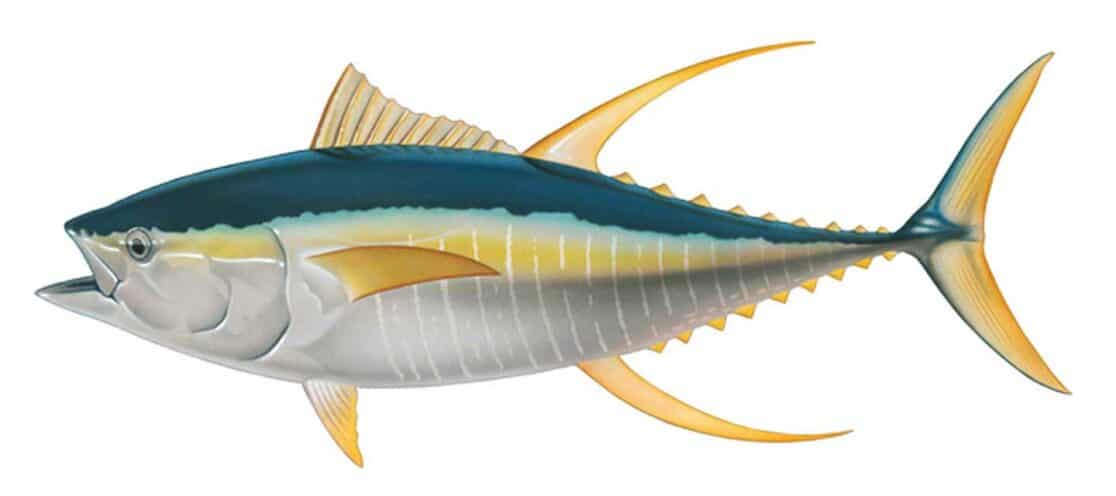
Latin Name: Thunnus albacares
Maximum Weight and Length: 400 lbs, 7 ft
Habitat: Tropical and subtropical waters worldwide, often near the surface or associated with floating objects. It can be found in warm currents in the Mediterranean, primarily in the eastern basin.
Distinguishing Features:
- A yellow dorsal fin and yellow sides
- Long second dorsal fin
- Dark blue-black back and silver-white belly
- Moderately large eyes
- Yellow finlets on the tail
- Also known as ‘ahi’ (Bigeye is also sometimes called ahi)
Taste and Texture: Yellowfin tuna has a bolder flavor and softer texture than albacore. This makes it ideal where a richer tuna taste is desired, such as sandwiches or pasta dishes.
Albacore
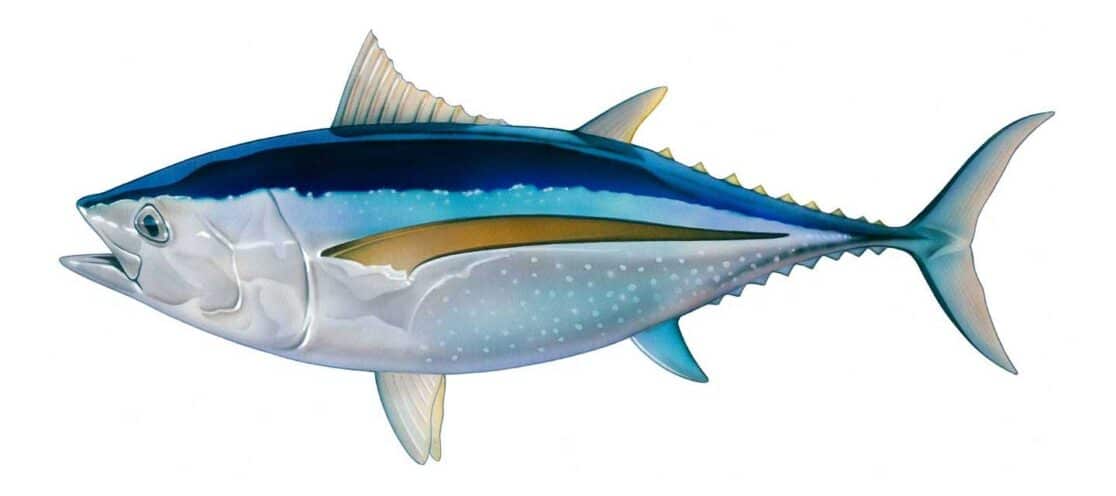
Latin Name: Thunnus alalunga
Maximum Weight and Length: 90 lbs, 5 ft
Habitat: Temperate and tropical waters worldwide, often preferring deep offshore areas.
Distinguishing Features:
- Torpedo-like body
- Large eyes
- Remarkably long pectoral fins
- Deep blue dorsally and shades of silvery white ventrally
- Unique diet preference for cephalopods (such as octopuses, squids, and cuttlefish)
Taste and Texture: Milder flavor than most tunas and meaty texture makes it suitable for many dishes, from salads to casseroles.
Bigeye
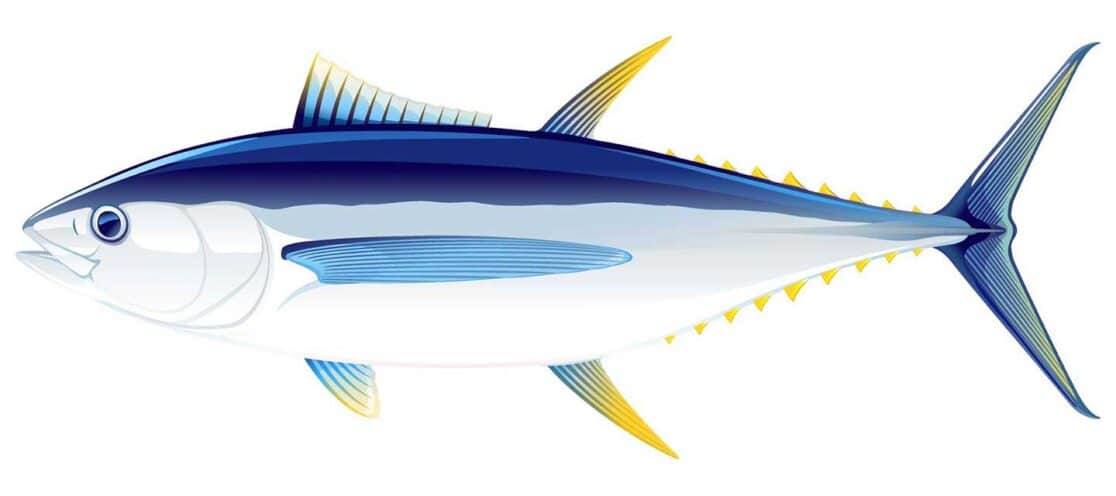
Latin Name: Thunnus obesus
Maximum Weight and Length: 400 lbs, 8 ft
Habitat: Deeper, warm waters in tropical and subtropical regions, often near islands or seamounts.
Distinguishing Features:
- Large, deep-bodied, streamlined fish
- Large head and eyes
- Very long pectoral fins
- 13 or 14 dorsal spines
- Unique physiology allowing them to forage in deeper, colder waters
- Also known as ‘ahi’ (Yellowfin is also sometimes called ahi)
Taste and Texture: Rich, sweet flavor with a clean, less “fishy” profile. The texture is firm and tender, ideal for searing or raw preparations.
Atlantic Bluefin
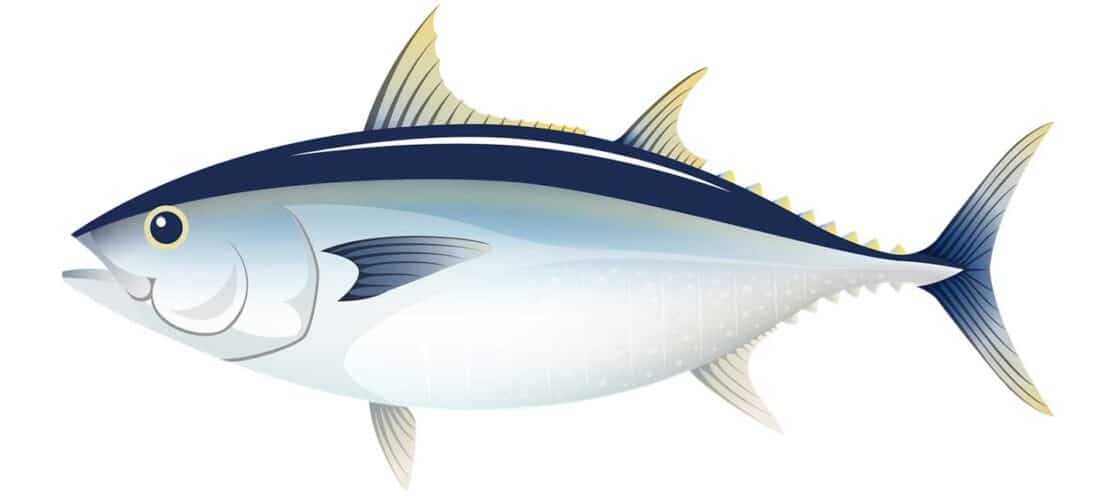
Latin Name: Thunnus thynnus
Maximum Weight and Length: 2,000 lbs, 10.5 ft
Habitat: Western and Eastern Atlantic Ocean, with the Mediterranean as a significant spawning ground. This species migrates long distances and is often found in cooler waters.
Distinguishing Features:
- Distinguishing Features:
- Dark blue coloring on the top and a gray or shimmering white coloring below
- Gold shimmer to the entire body
- Dark red meat
- Tips of pectoral fins do not reach the front of the second dorsal fin
Taste and Texture: Mild, buttery, and savory flavor, with a subtle sweetness. The texture is firm and smooth, often enjoyed raw in sushi and sashimi.
Pacific Bluefin
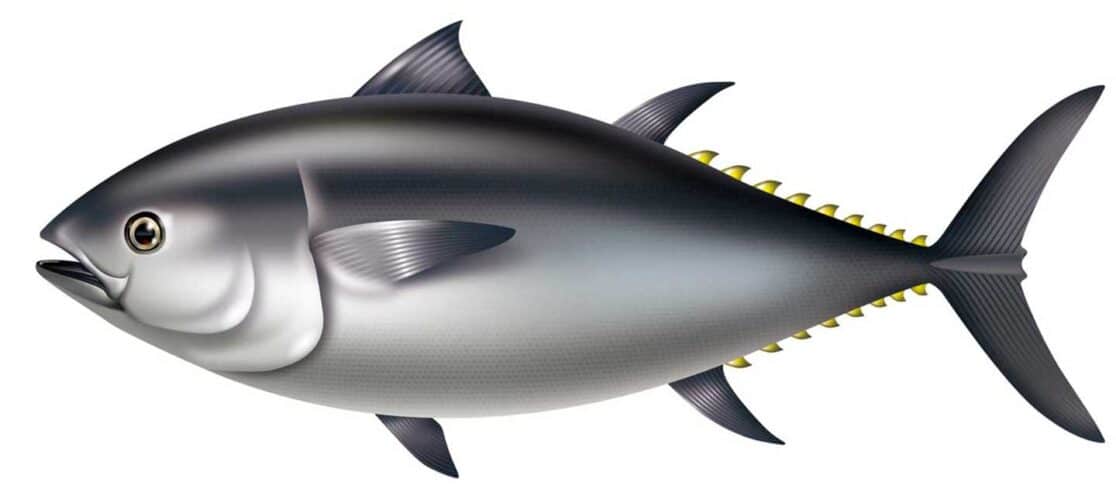
Latin Name: Thunnus orientalis
Maximum Weight and Length: 990 lbs, 10 ft
Habitat: The Pacific Ocean, ranging from east to west, and known for long-distance migrations.
Distinguishing Features:
- Black or dark blue dorsal sides with a grayish-green iridescence
- Small eyes compared to other tuna species
- Pectoral fin tips do not reach the front of the second dorsal fin
Taste and Texture: Pacific Bluefin has a distinct, succulent flavor with an oceanic essence. Its texture is firm and slightly chewy.
Southern Bluefin
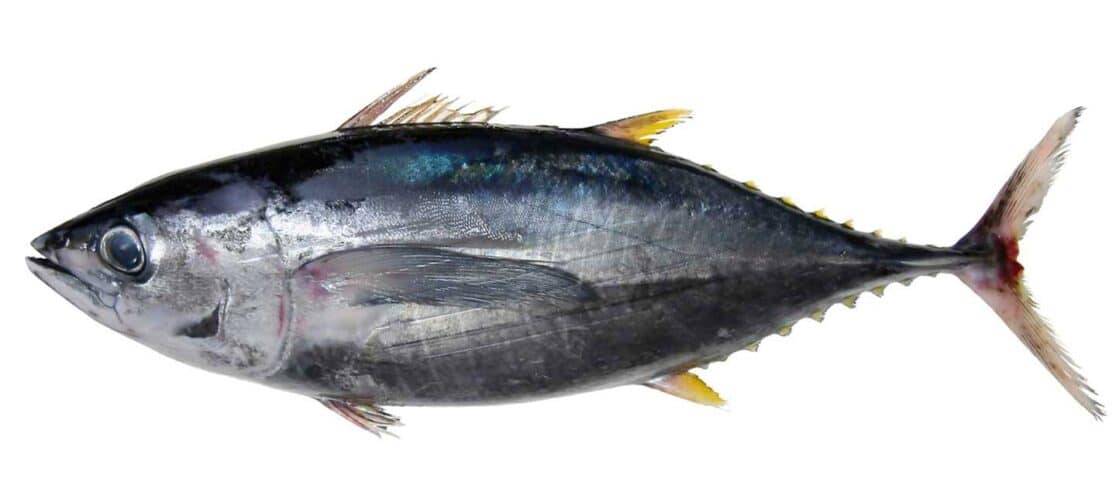
Latin Name: Thunnus maccoyii
Maximum Weight and Length: 1,210 lbs, 8 ft
Habitat: The southern hemisphere’s temperate and cold waters, often found in the open ocean.
Distinguishing Features:
- Found in open southern Hemisphere waters mainly between 30°S and 50°S
- Maintains body core temperature up to 10°C above ambient temperature
- Unique respiratory and circulatory adaptations for high metabolic demand
Taste and Texture: Southern Bluefin is buttery, smooth, and has a melt-in-your-mouth tender feel because it is marbled with fat.
Nutrition and Health Benefits
The U.S. Food and Drug Administration recommends adults to eat 2 to 3 servings of a variety of cooked fish, or about 8 to 12 ounces, per week. Tuna, in particular, is rich in protein, vitamin D, vitamin B12, potassium, and also features EPA and DHA omega-3 fatty acids. Protein is essential for building strong bones, muscles, cartilage, and skin. Vitamin D is critical for bone health and supports the immune system. Vitamin B12 is necessary for red blood cells, nerve function, and DNA production. EPA and DHA omega-3s play a key role in the inflammatory pathways in the body and also support brain, heart and eye health. Learn more about how tuna is good for you.
Tuna in Cans and Packets
Most canned or pouched tuna comes from skipjack, yellowfin, or albacore tuna. Light or chunk light tuna is typically a mix of skipjack and yellowfin, sometimes including tongol or bigeye tuna. These varieties are commonly used for classic dishes such as tuna macaroni salad and tuna melts. Albacore, known for its light-colored flesh, firm texture, and mild flavor, is considered white tuna, including solid white and chunk white. Some people prefer it over light tuna for dishes such as tuna patties that require a milder flavor and a firmer, more steak-like fish. The National Fisheries Institute states that about 70% of canned and pouched tuna consumed in the United States is skipjack (or a small amount of yellowfin tuna), with around 30% being albacore.
FREQUENTLY ASKED QUESTIONS
What are the different types of tuna?
There are 15 different types of tuna. In the commercial tuna market, there are 7 “main” species and 8 “minor” species. The main types are: Skipjack, Albacore, Yellowfin, Bigeye, Atlantic Bluefin, Pacific Bluefin, and Southern Bluefin. The minor species are: Black Skipjack, Blackfin, Bullet, Frigate, Kawakawa, Longtail or Tongol, Little Tunny, and Slender.
What are the five main types of tuna used in sushi?
The primary tuna varieties used in sushi are bluefin (especially prized), bigeye, yellowfin, albacore, and sometimes skipjack. Bluefin is highly valued for its rich, fatty texture, while others offer varying degrees of flavor and texture.
What is the best kind of tuna to eat?
“Best” is subjective and depends on preference. Bluefin is considered a delicacy for sushi, while albacore and yellowfin are popular for steaks and grilling. Skipjack is common in canned tuna.
Which tuna is better, yellowfin or albacore?
Yellowfin and albacore offer distinct qualities. Yellowfin has a mild flavor and firm texture, suitable for various cooking methods, while albacore is known for its light flesh and higher omega-3 content. Personal preference and intended use determine which is “better.”
Which is more expensive, yellowfin or bluefin tuna?
Bluefin tuna is significantly more expensive than yellowfin. Bluefin’s scarcity, high demand, especially for sushi, and exceptional quality drive its premium price.
Which type of tuna tastes best?
There’s no one-type-is-best answer. The three main types of canned tuna–albacore, yellowfin, and skipjack–offer unique tastes. Depending on your recipe, you may prefer albacore, which has the mildest flavor and a meaty texture, yellowfin, which has a richer flavor and softer texture, or skipjack, which has the most robust, fishy flavor and is also a soft texture.
What is the rarest type of tuna?
The rarest type of tuna is generally considered to be the Atlantic Bluefin Tuna (Thunnus thynnus). This species is highly sought after, especially in Japan for sushi and sashimi dishes, and so has faced significant overfishing, leading to a sharp decline in population numbers. Conservation efforts have been implemented to protect and rebuild the population of this species.
Sources:
- https://www.iss-foundation.org/tuna-stocks-and-management/tuna-fishing/tuna-species
- https://ocean.si.edu/ocean-life/fish/big-tunas
- https://www.fisheries.noaa.gov/find-species
- https://www.americanoceans.org/marine-life-species/
- https://www.fda.gov/food/consumers/questions-answers-fdaepa-advice-about-eating-fish-those-who-might-become-or-are-pregnant-or#II

WHERE TO BUY
Overflowing with flavor, Chicken of the Sea packets and cans are ready for all your culinary adventures. Use our product locator to find the perfect salmon, tuna, crab or other seafood products from Chicken of the Sea.







